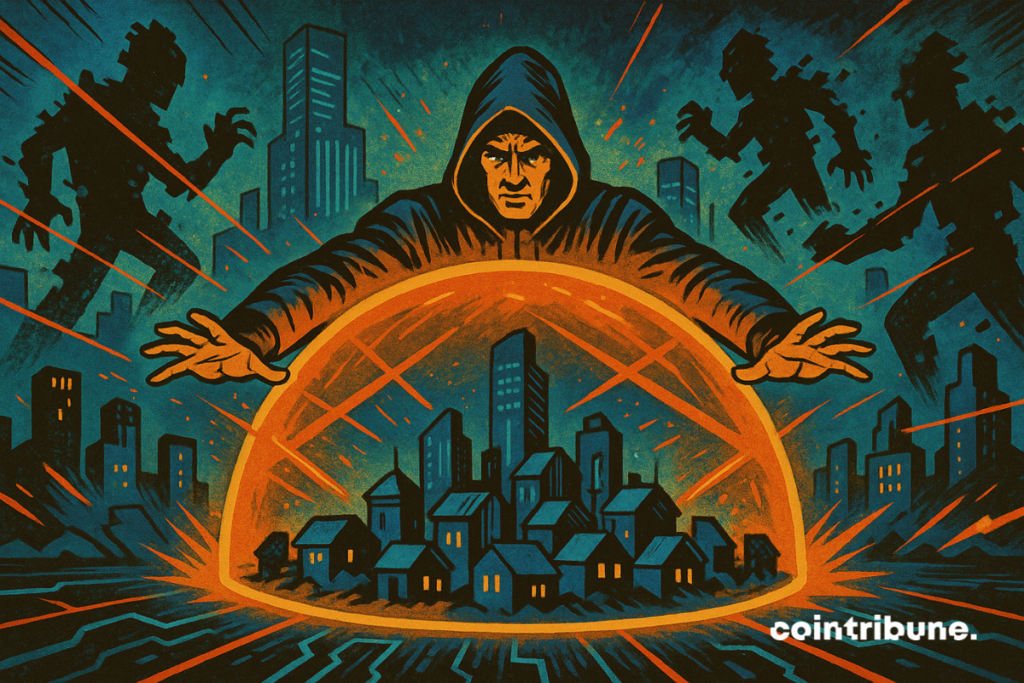Naoris Protocol Slashes Cyber Threats With Decentralized Defense
Forget legacy security—this blockchain-based watchdog turns every device into a sentry. Wall Street’s firewalls just got schooled by cryptography.
How it works: Nodes police each other in real-time, creating a self-healing network that laughs at brute-force attacks. No more single points of failure—just Byzantine fault tolerance kicking hackers to the curb.
The kicker? Enterprises pay premiums for this while still running Excel ’97. Some things never change—except maybe their security budgets after the next breach.

In Brief
- Naoris Protocol prepares the Internet for the post-quantum era with decentralized security.
- It combines advanced cryptography, cybersecurity consensus, and swarm intelligence.
- With a record testnet and a public sale underway, the network is already operational.
David Carvalho: From Ethical Hacker to Architect of Trust
Carvalho’s journey resembles a global tech thriller: raised among rivers and farm animals, passionate about ants and pattern recognition, introduced to programming by a computer too slow for games. As a teenager, he was already decompiling code. As an adult, he became CISO for entities such as London Airport and the OCS group with its 100,000 employees. He then advised NATO member states on cyber conflicts and the vulnerabilities of centralized systems.
The turning point came during a feverish night. Bedridden, he ironically felt relief: he didn’t have to go to work. This clarity pushed him to leave the corporate world to launch ZAP (Zero Attitude Policy), which later became Naoris Protocol.
Why Is Digital Trust Broken?
Today, digital systems, whether from Web2 or Web3 blockchains, share the same structural flaw: they rely on centralized trust. A single compromised node, server, or smart contract can bring down an entire system. The explosion of connected devices and AI-powered attacks expands the attack surface every day.
And quantum computing is coming. Algorithms like Shor’s or Grover’s could break the current RSA and elliptic curve cryptography systems that FORM the backbone of cybersecurity. This critical moment is called. Its arrival is no longer a matter of if, but when.
Recent advances have significantly accelerated this timeline. A recent study by Google Quantum AI shows that RSA-2048 encryption, the security pillar used by banks, email services, and government systems, could be broken in less than a week with fewer than one million noisy qubits. This represents a 95% reduction compared to earlier estimates that required 20 million qubits. According to this analysis, hardware roadmaps aim to solve technical challenges to achieve this capability by the early 2030s.
Naoris Protocol: A “Village” of Trust at Internet Scale
In the interview, Carvalho uses a simple metaphor: imagine a village where everyone knows whom they can trust. If a newcomer arrives, the group can validate or reject them by consensus. Naoris Protocol applies this model to machines.
Operating on what he calls the, underlying even LAYER 0 blockchains, Naoris combines three advanced technologies:
- Post-quantum cryptography (Dilithium-5 and KEMs): compliant with NIST, NATO, and ETSI standards;
- dPoSec (Decentralized Proof of Security): a consensus validating the cyber integrity of each device;
- Swarm AI: a decentralized networked intelligence that detects and neutralizes threats in real time.
These building blocks form a self-healing mesh network with no single point of failure, applicable to both Web3 and Web2 systems.
Naoris does not aim to replace existing blockchains or infrastructures. It complements them. No hard forks, no migration. Real-time validation and post-quantum readiness are integrated from the design phase.
A Record-Breaking Testnet
Since launching its testnet in January 2025, Naoris Protocol has shown unprecedented growth:
- More than 14 million post-quantum transactions processed;
- More than 1.1 million validator nodes registered;
- More than 133 million threats mitigated;
- More than 1 million wallets created in 30 days, a figure surpassing the early years of many layer 1 blockchains.
This momentum is supported by, with investors likeand several family offices from Europe, Asia, and the United States.
Naoris is not just about concepts: it is the first blockchain to process live post-quantum encrypted transactions, preparing companies and protocols forwithout service interruption.
What This Means: The Countdown to Q-Day
Governments are already preparing. In the United States, federal contractors must adopt post-quantum security measures by 2030. According to the National Institute of Standards and Technology (NIST), all cryptographic systems vulnerable to quantum attacks should be retired after 2030 and banned after 2035. Over the past five years, China has invested more in quantum technologies than in nuclear.
The threat is already concrete: adversaries are currently collecting encrypted data to decrypt it later. The so-called “collect now, decrypt later” strategy is not a conspiracy theory but a real concern recognized by both the United States and China. Yet, most blockchains and companies remain locked in vulnerable, centralized architectures.
And Now: Public Sale & Community Involvement
The public sale oftokens is now open. It invites individuals and institutions to actively participate in building a new digital trust model.
Whatever your profile, developer, validator, investor, or simple curious onlooker – you can:
- Download the Naoris wallet;
- Join the testnet as a security node;
- Explore the technology via the official website or the knowledge base.
The story of David Carvalho, from a curious child hacker to protector of digital infrastructures, is not only inspiring. It is a warning signal. In a world moving toward a quantum rupture, digital trust needs more than passwords or firewalls. It demands resilience, decentralization, and mathematically verifiable truth.
The Naoris Protocol project does not patch vulnerabilities; it redefines the foundations. Now is the time to join the network.
Maximize your Cointribune experience with our "Read to Earn" program! For every article you read, earn points and access exclusive rewards. Sign up now and start earning benefits.

